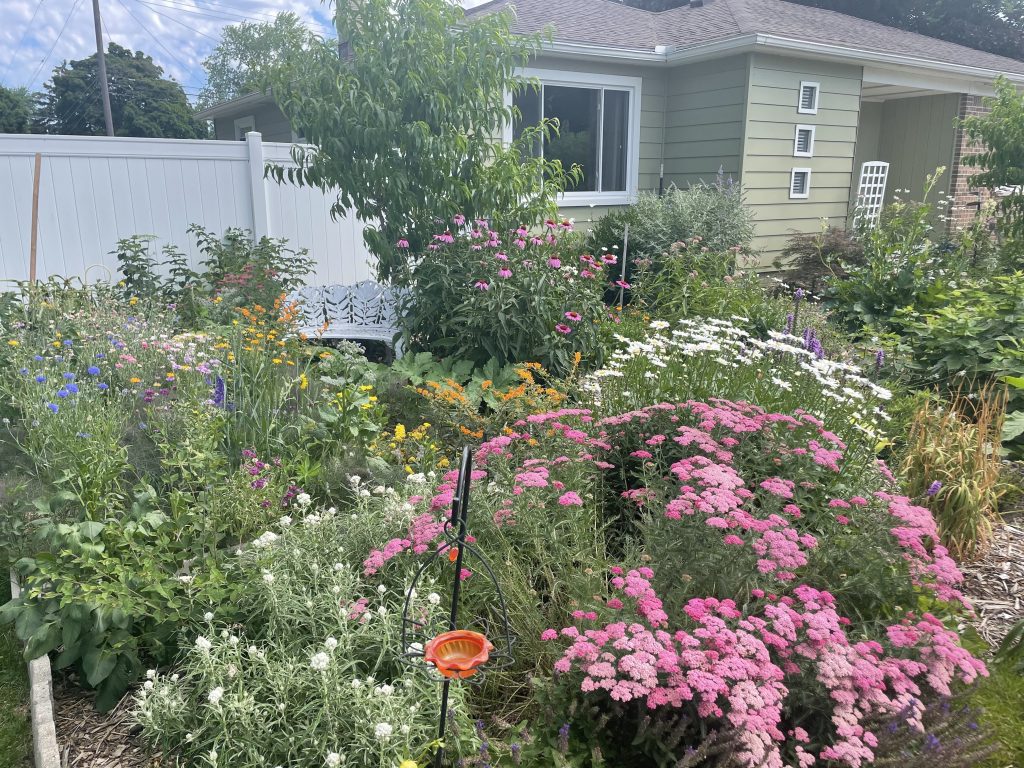Essential Cooking: Planting a food forest with Samantha Stanisz
In this episode of Essential Cooking, Ann Delisi and Chef James Rigato speak with Samantha Stanisz about how she transformed her grass lawn into a food forest, and how you can do the same.

Plants grown on a front lawn instead of grass constitute a "food forest," says Samantha Stanisz.
Winter is the time to make a plan to transform your lawn into a food forest. In this episode of Essential Cooking, Ann Delisi and Chef James Rigato speak with Samantha Stanisz about how she transformed her grass lawn into a food forest of her own, and how you can do the same.
Subscribe wherever you listen to podcasts:
Apple Podcast — Spotify — Google Play — Stitcher — NPR
In this episode:
- How to get started growing food in your own backyard
- Natural ways to keep pests off of your produce
- What it means to turn your lawn into your very own food forest
- Growing fruit trees in Michigan
One morning, Chef James Rigato and his partner Samantha Stanisz rolled a tarp onto their lawn to kill their grass and start the process of transforming their front yard into a food forest. Stanisz spoke with Ann Delisi and Chef Rigato about what a food forest is, and how to make one for yourself.
Stanisz got started by transforming a small section of her lawn with fruit trees, with Chef Rigato’s help.
“We had some terrible corner that was abandoned, and we dug it out and made it a little more ground cover, perennial grasses, a little more healthy for the soil,” Chef Rigato explains. “Then we planted fruit trees. That was our first landscaping.”
That first bit of landscaping led to raised beds, vegetables and eventually Stanisz installed a hoop house — a sort of portable greenhouse used to keep the ground warm for extended growing. Although not everyone is going to make this kind of investment, Stanisz believes that everyone can transform their yard in one way or another.
“I feel like the most important thing to ask yourself is, ‘What do you want to see in your yard, and what do you want to get out of your yard,’” Stanisz explains. “Do you want to just see butterflies and bees? Then plant lots of flowers. Do you want to grow food for yourself and be more sustainable? Then we can go larger. But it can be as small as one little pot with one little tomato plant. That’s usually how it starts.”
“I want people to feel the same things I was feeling while learning all about this, and growing food for yourself, and realizing how powerful you can feel when you grow these things.” — Samantha Stanisz
Stanisz eventually transformed her entire lawn into a food forest, which is a way of gardening that seeks to imitate the way plants grow naturally. Food forests consider what plants will benefit from each other and aim to make the plants as self-sufficient as possible.
“So when you go into a forest that is untouched, you see the tall trees, they’re the canopies that cover everything, and then you’ll see fruit bushes,” Stanisz explains. “There are seven layers to a forest from the tall trees, to the bushes, to the vining, the ivy and whatever it may be. Then you see ground cover, which contains the soil and keeps all the nutrients in it, and maybe a few in between. But you want to mimic nature.”
Stanisz uses her produce to eat, to preserve and to use at Mabel Gray, Chef Rigato’s restaurant in Hazel Park. Beyond the financial savings and sustainability, Stanisz has a much deeper connection to growing food that she wants others to experience.
“I want people to feel the same things I was feeling while learning all about this, and growing food for yourself, and realizing how powerful you can feel when you grow these things,” Stanisz says. “And then you eat it and all of that energy that you put into the plant can come back to you.”
Since she started her food forest project, Stanisz has noticed that those in her neighborhood have been adding birdbaths and trees to their own landscaping.
“It’s cool to see the ripple effect,” Stanisz says. “Neighbors will start to plant trees in their yard, or get a bird bath because they see the birds in our yard. People just see something cool like that and want to follow.”
More from Essential Cooking:
- Extend Your Growing Season With a Hoop House
- How Do Honeybees Survive Winter? And Other Questions For A Beekeeper
- Deeply Rooted Produce works to transform Detroit’s food system with hyperlocal produce delivery
Trusted, accurate, up-to-date.
WDET strives to make our journalism accessible to everyone. As a public media institution, we maintain our journalistic integrity through independent support from readers like you. If you value WDET as your source of news, music and conversation, please make a gift today.
